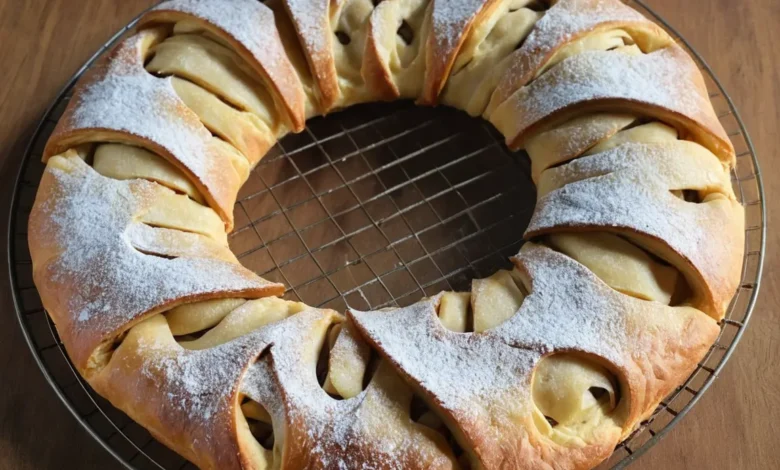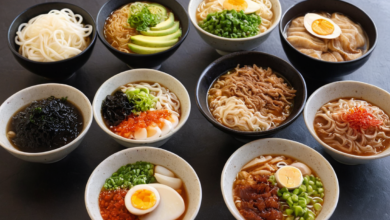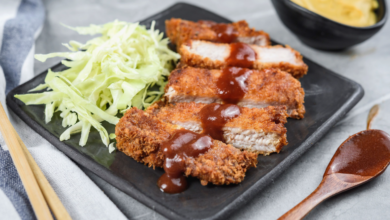Kringle: The Delicious Scandinavian Pastry You Need to Try Today!

Kringle, the buttery and flaky Scandinavian pastry, is a sweet treat that’s gaining popularity around the world. Originating from Denmark, this pastry is typically shaped into an oval or pretzel-like form and filled with a variety of delicious ingredients like almond paste, pecans, and fruits. Perfect for breakfast, dessert, or an afternoon snack, kringle offers a melt-in-your-mouth experience that combines rich flavors with an irresistible texture. In this blog, we’ll dive into the history of kringle, explore the different types available, and answer some frequently asked questions to help you better appreciate this delightful pastry.
What is Kringle?
Kringle is a traditional pastry that comes from Denmark and has spread across Scandinavian regions and the U.S., particularly in places like Wisconsin, where Danish immigrants introduced this delicious treat. The pastry is made from layers of dough, similar to puff pastry, that are filled with various sweet or savory ingredients. The most common fillings include almond paste, pecans, and cream cheese, but many bakers experiment with flavors like apple, cherry, or raspberry to create unique variations.
A Brief History of Kringle
Kringle has its origins in the Danish baker’s guild of the 13th century, where it was a symbol of honor and craftsmanship. The name “kringle” comes from the Old Norse word for “ring” or “circle,” a nod to its traditional shape. Danish bakers perfected this layered pastry technique over centuries, and when Danish immigrants came to the U.S., particularly Wisconsin, they brought kringle with them. Today, Racine, Wisconsin is known as the “Kringle Capital of the World,” and it’s here that kringle has become a beloved treat, enjoyed year-round but especially popular during the holidays.
Types of Kringle
While traditional kringle is made with almond paste and shaped into a pretzel or oval, modern versions offer a variety of fillings and shapes. Here are some of the most popular types:
- Almond Kringle
This is the classic version, filled with rich almond paste and topped with sliced almonds. The almond filling provides a sweet and slightly nutty flavor that balances perfectly with the buttery pastry. - Pecan Kringle
Pecan kringle is another favorite, filled with a sweet and crunchy pecan mixture. Often drizzled with icing, this version has a delightful contrast of textures, combining the flaky pastry with the rich, nutty filling. - Fruit-Filled Kringle
For those who prefer something fruity, kringles filled with apple, cherry, or raspberry are popular choices. These versions often include a cream cheese layer that adds an extra layer of richness to the fruit filling. - Savory Kringle
Although less common, savory kringles are also made using ingredients like cheese, ham, and spinach. These make for a perfect brunch or light dinner option, offering a unique twist on the classic sweet pastry.
How is Kringle Made?
Kringle is made using a lamination technique, similar to how croissants are made. The dough is layered with butter and folded multiple times to create a flaky texture. Here’s a simplified overview of the kringle-making process:
- Step 1: Prepare the Dough
The dough is made with flour, yeast, sugar, and butter. After it’s prepared, the dough is rolled out and butter is added between the layers to create the signature flaky texture. - Step 2: Fold the Dough
The dough is folded multiple times to create many thin layers, similar to puff pastry. This step is essential for giving kringle its light, airy texture. - Step 3: Add the Filling
After the dough has been folded and rolled out, it’s filled with ingredients like almond paste, pecans, or fruit. The filled dough is then shaped into an oval or pretzel form. - Step 4: Bake and Glaze
The kringle is baked until golden brown and flaky. After baking, many kringles are drizzled with icing or topped with nuts for added flavor and visual appeal.
Why Kringle is Perfect for Any Occasion
Kringle is more than just a pastry—it’s a symbol of celebration and indulgence. Whether you’re enjoying it with your morning coffee, bringing it to a family gathering, or giving it as a gift, kringle fits any occasion. Its versatility, with both sweet and savory options, means there’s a version for everyone. Moreover, kringle’s long shelf life—thanks to the butter and sugar content—makes it a great treat to enjoy over several days.
Is Kringle Healthy?
While kringle is undeniably delicious, it’s still a treat best enjoyed in moderation. The layers of butter and sugar make it a high-calorie pastry, but it does provide some nutritional benefits from ingredients like almonds and pecans, which offer healthy fats and fiber. If you’re watching your sugar intake, consider enjoying a smaller portion or trying a savory kringle option.
Frequently Asked Questions About Kringle
- What makes kringle different from other pastries?
Kringle stands out because of its flaky layers and unique fillings. The lamination process, which involves folding butter into the dough, creates a light, airy texture that’s hard to replicate with simpler pastries. - Can you make kringle at home?
Yes! While making kringle can be time-consuming due to the folding process, there are many recipes available online that guide you step by step. Alternatively, you can purchase pre-made kringle from bakeries or specialty stores. - How long does kringle stay fresh?
Kringle can last up to 5 days when stored in an airtight container at room temperature. You can also freeze it for up to 6 months to enjoy later. - Where can I buy authentic kringle?
Authentic Danish kringle can be found in specialty bakeries, especially in places with large Danish communities like Wisconsin. Many bakeries also ship kringle nationwide, allowing you to enjoy this delicious pastry no matter where you are. - Is there a gluten-free version of kringle?
While traditional kringle contains wheat flour, some bakeries offer gluten-free versions made with alternative flours. Be sure to check labels or inquire with the bakery for specific dietary needs.
Conclusion
Kringle is a pastry that brings joy to anyone who tastes it. Its flaky layers, rich fillings, and versatility make it a favorite for both everyday treats and special occasions. Whether you’re enjoying a slice of pecan kringle with your morning coffee or savoring a fruit-filled version for dessert, this Scandinavian delight is sure to please. Next time you’re looking for something sweet and satisfying, try kringle—you won’t be disappointed!





